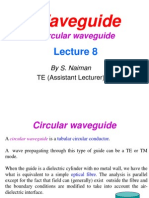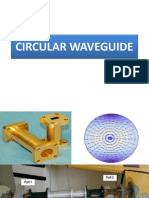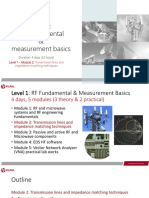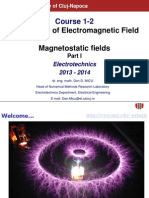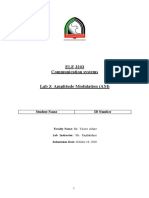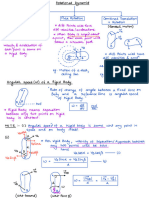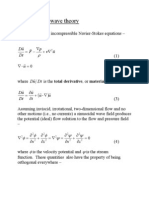Circular Waveguide
Uploaded by
Lam DinhCircular Waveguide
Uploaded by
Lam DinhSOP TRANSACTIONS ON WIRELESS COMMUNICATIONS
ISSN(Print): 2373-8618 ISSN(Online): 2373-8626
Volume 1, Number 2, July 2014
SOP TRANSACTIONS ON WIRELESS COMMUNICATIONS
A Novel Approach to Analyze a Circular
Waveguide in Air and Dielectric Medium
R. K. Kushwaha1 *, S. Srivastava2 , Vijayshree Chaursiya3
1
Department of Electronics & Communication Engineering, Patel Group of Institution , Bhopal, ( M.P), India
Department of Materials Science and Metallurgical Engineering, Maulana Azad National Institute of Technology, Bhopal (M.P.),
India
*Corresponding author: riteshkushwaha@gmail.com
2,3
Abstract:
In this article we reported 41 possible Mode for transverse electric and transverse magnetic
wave along with all its parameter like cutoff frequency, cutoff wavelength, group wavelength,
phase velocity, group velocity, propagation constant, impedance measurement and attenuation
constant for a given structure parameter and operating frequency in air and dielectric medium
circular waveguide. MATLAB 7.6 is used to simulate all the results. It is found that dominant
mode of TE and TM waves gives maximum values except few cases and dielectric circular
waveguide shows better results as compared to air medium. Barium tetratitanate is taken as a
dielectric filler material for this article.
Keywords:
Barium Tetratitanate; Dominant Mode; Circular Waveguide; TE Mode; TM Mmode
1. INTRODUCTION
The attention of propagating electromagnetic mode inside waveguide has received considerable attention
due to its importance in the development. Several authors [14] have successfully used the boundary value
solution for electromagnetic field inside a circular waveguide. The use of this concept greatly simplifies
the solution and allows the field in the waveguide to be expressed in simple form for easy comparisons
form with other type of circular waveguide. Circular waveguide offers lower attenuation than alternative
waveguides and is capable of providing dual polarized operation. Since circular waveguide typically
operates above the cutoff frequency of at least one of the higher order modes, these properties are only
beneficial if the circular waveguide is made very accurately [5]. Application that is more important has
been in television where waveguide methods provide a very special feature. Circular wave Guide is shown
in Figure 1.
A dielectric is a non conductor of electric current. This theory is based on Maxwells equations
[6]. In circular waveguide a infinite number of modal field distribution can be generated with the help
of mathematical formulation of Bessels constant, Transverse Electric and Transverse Magnetic field
equations. C.S. LEE and S.L. CHUNG (1985) gave first 30 modal field distribution of rectangular/circular
waveguide [7]. A recent papers has described some work that has been undertaken to address this need
1
SOP TRANSACTIONS ON WIRELESS COMMUNICATIONS
Figure 1.
Circular wave guide
specifically, the use of dielectric waveguide as a suitable transmission medium for this part of the
electromagnetic spectrum. In [8], the choice of material for the dielectric waveguide was discussed,
along with design schemes for components including Vector Network Analyzer (VNA) test ports and
the standards needed to calibrate VNAs. Dielectric waveguide has several advantages over other more
traditional transmission lines (e.g. coaxial line and metallic rectangular waveguide) at these frequencies.
The necessary mechanical sizes and tolerances of the waveguide dimensions are easier to maintain. Also,
since these dimensions correspond to the external boundaries of the waveguide, they are easy to verify
using simple mechanical measurement techniques [9]. In the present article is to give a broad perspective
with historical emphasis on the theory of Electromagnetic wave propagation and various parameters like
cutoff frequency, cutoff wavelength, group wave length, attenuation, power distribution etc has been
compared in air/dielectric circular waveguide.
The present study is organized as follows. In Section II describe the basic concept the operational
principle and geometry of circular waveguide. In Section III we describe the results and discussion of
experiments within the computing environment MATLAB 7.6 while Section IV contains the conclusions.
2. PRINCIPLE AND GEOMETRY OF CIRCULAR WAVEGUIDE
Wave Guide is single conductor wire transmission line. It supports only Transverse Electric (TE) and
Transverse Magnetic wave (TM).Any shape of cross section of a waveguide can support electromagnetic
waves. But since irregular shapes are difficult to analyze and are rarely used. The circular waveguide is a
most common and used to twist the waves as theses travel through them. However circular waveguides
are used with rotating antenna as in radar.
2.1 MAXWELLS EQUATIONS
Electromagnetic waves were first postulated by James Clerk Maxwell and subsequently confirmed
by Heinrich Hertz. Maxwell derived a wave form of the electric and magnetic equations, revealing the
wave-like nature of electric and magnetic fields, and their symmetry. Because the speed of EM waves
2
A Novel Approach to Analyze a Circular Waveguide in Air and Dielectric Medium
predicted by the wave equation coincided with the measured speed of light, Maxwell concluded that light
itself is an EM wave.
Electric and magnetic phenomena at the macroscopic level are described by Maxwells equations, as
published by Maxwell in 1873. The general form of time-varying Maxwell equations, can be written in
differential form as
E =
B
x
(1)
H =
D
+J
x
(2)
D = r
(3)
B = 0
(4)
These quantities are defined as follows:
E is the electric field intensity, in V/m.
H is the magnetic field intensity, in A/m.
D is the electric flux density, in Coul/m2 .
B is the magnetic flux density, in Web/ m2 .
M is the (fictitious) magnetic current density, in A/m2 .
J is the electric current density, in A/m2 .
r is the electric charge density, in Coul/m3 .
According to Maxwells equations, a spatially-varying electric field generates a time-varying magnetic
field and vice versa. Therefore, as an oscillating electric field generates an oscillating magnetic field, the
magnetic field in turn generates an oscillating electric field, and so on. These oscillating fields together
form an electromagnetic wave.
2.2 Circular Wave Guide
A circular waveguide is metallic or tubular structure supports TE and TM waveguide modes. The
circular cross-section cylindrical wave guide geometry is shown in Figure 2.
The transverse fields in cylindrical coordinates can be derived from E or H. field components, for TM
and TE modes, respectively. The cylindrical components of the transverse fields can be derived from the
longitudinal components as [9]:
Er =
j
kc2
Ez w Hz
b
+
r
r j
(5)
3
SOP TRANSACTIONS ON WIRELESS COMMUNICATIONS
Figure 2.
Geometry of a circular waveguide
Ej =
Hr =
Er =
Where kc2 = k2
j
kc2
j
kc2
j
kc2
b Ez
r j
we Ez
r j
we
Hz
w
r
(6)
Hz
r
(7)
Ez b Hz
+
r
r j
(8)
b2
2 Hz + k2 Hz = 0
(9)
(i) TE MODES
For TE modes Ez =0 and Ez is a solution to the wave equation [10].
If, (9) can be expressed in cylindrical coordinates as
2
1
2
2
+
+
+
k
c hz (r, j) = 0
r2 r r j2
(10)
By using the method of separation of variables. Thus we get
hz (r, j) = R (r) P (j)
(11)
1 2R
1 R
1 2P
+
+ 2
+ kc2 = 0
2
R r
rR r r P j 2
(12)
and Substitute into (10) to obtain
r 2 2R r R
+
+ r 2 kc2 =
R r2 R r
1 2P
P j2
(13)
A Novel Approach to Analyze a Circular Waveguide in Air and Dielectric Medium
The left side of this equation depends on r (not j), while the right side depends only on j, thus, each
side must be equal to a constant, which we will call kj2 . Then
2P
+ kj2 P = 0
j2
(14)
Also,
r
2R
R
+r
+ r 2 kc2
r2
r
kj2 R = 0
(15)
The general solution to (14) is
P (j) = Asinkj j + Bcoskj j
(16)
Since the solution to hz must be periodic in j , kj must be an integer, n. Thus (16) becomes
P (j) = Asinnj + Bcosnj
(17)
While 15 becomes
r
2R
R
+r
+ r 2 kc2
2
r
r
n2 R = 0
(18)
Equation (18) is recognized as Bessels differential equation. The solution is
R (r) = CJn (kc r) + DYn (kc r)
(19)
Where Jn (x) and Yn (x) are the Bessel function of the first and second kinds, respectively. Since Yn (kc r)
becomes infinite at, r=0, this term is physically unacceptable for the circular waveguide problem so that
D=0. The solution for hz , can then be written as
hz (r, j) = (Asinnj + Bcosnj) Jn (kc r)
(20)
where the constant C of (19) has been absorbed in to the constant A and B of (20). We must still
determine the cutoff wave number kc , which we can do by enforcing the boundary condition that Etan =0
on the waveguide wall. Since Ez =0, we must have that
Ej (r, j) = 0, at = a
(21)
From (6), we find Ej from Hz as
Ej (r, j, z) =
0
jw
(Asinnj + Bcosnj) Jn (kc r) e
kc
jb z
(22)
5
SOP TRANSACTIONS ON WIRELESS COMMUNICATIONS
Table 1. Value of p0 nm for TM Modes of a Circular Waveguide
p0 /n
p0 n1
3.832 1.841
3.054
4.201
5.317
5.416
p0 n2
7.016 5.331
6.706
8.015
9.282
10.520
p0 n3
10.173 8.536
9.969
11.346
12.682
13.987
p0 n4
13.324 11.706
13.170
Where the notation of Jn (kc r) refer to the derivation of Jn with respect to its argument. For Ej to
vanish at r = a, we must have
0
Jn (kc a) = 0
(23)
0
0
0
0
0
If the roots of Jn (x) are defined as pnm , so that J n pnm = 0, where pnm is the mth root of J n , then kc
must have the value
kcnm =
pnm
a
(24)
Value of pnm are given in mathematical table, the first few values are listed in Table 1
0
The TEnm modes are in thus defined by the cutoff wave number, Kcnm = pnm /a, where n refer to
the number of circumferential (j) variations, and m refers to the number of radial (r) variation. The
propagation constant of the TEnm mode is [10]:
b nm =
k2
kc2 =
k2
(25)
(pnm /a)
With cutoff frequency of
fcnm =
kc
p
(26)
2p e
0
The first TE mode to propagate is the mode with the smallest pnm , which from Table 1 is seen to be the
TE11 mode. This mode is then the dominant circular waveguide mode, and the one most frequently used.
Because m 1, there is no TE10 , but there is a TE01 mode.
The transverse field components are, from (1), (2), (3), (4) and (18),
Er =
jw n
(A cosnj B sinnj) Jn (kc r) e
kc2 r
Ej =
0
jw
(A sinnj+B cosnj) Jn (kc r) e
kc
Hr =
0
jb
(A sinnj+B cosnj) Jn (kc r) e
kc
jb z
(27)
jb z
(28)
jb z
(29)
A Novel Approach to Analyze a Circular Waveguide in Air and Dielectric Medium
Figure 3.
Model field distribution for TEnm mode
Hj =
jb n
(A cosnj B sinnj) Jn (kc r) e
kc2 r
Hz (r,j) = (Asinnj+Bcosnj)Jn (kc r)e
jb z
jb z
(30)
(31)
The wave impedance is
ZT E =
Er
=
Hj
Ej
hk
=
Hj
b
(32)
The power flow down the guide for TE11 can be computed as [10]:
R 2p
E H zb rdjdr
r=0 j=0
i
R a R 2p h
1
rdjdr
Re
E
H
E
H
r j
j r
r=0 j=0
2
i
h
w |A|2 Re(b ) R a R 2p
1
2 jJ 2 (k r) +k2 sin2 jJ 0 2 (k r) rdjdr
cos
c
c
4
2
n
c
n
r=0 j=0 r
2kc
h
i
pw |A|2 Re(b ) R a
1 2
2 J 0 2 (k r) dr
J
(k
r)
+rk
c
c
4
2
c
r=0
1
n1
2kc
r
pw |A|2 Re(b ) 0 2
2
(p
1)J
11
1 (kc r)
4k4
Po = 12 Re
=
=
=
=
Ra
(33)
SOP TRANSACTIONS ON WIRELESS COMMUNICATIONS
Figure 4.
TEnm field pattern
The attenuation due to a lossy waveguide conductor can be found by computing the power loss per unit
length of guide:
A Novel Approach to Analyze a Circular Waveguide in Air and Dielectric Medium
(a) Radius Vs wave length plot for TE wave (air medium)
(b) Wave length plot for TEnm wave in dielectric (Barium
tetratitanate) medium
Figure 5.
Wave length plot
Pl =
Rs
2
Rs
2
Rs |A|2
2
2p
s |Jn |2 adj
j=0
2p h
j=0
Hj
2p
i
+ |Hz |2 adj
b2
cos2 j + sin2 j
kc4 a2
j=0
pRs a|A|2
b2
1
+
J12 (kc r)
2
kc4 a2
(34)
J12 (kc r) adj
The attenuation constant is then
Rs kc4 a2 + b 2
Pl
Rs
ac =
=
=
02
2P0
akhb
hkb a p11 1
kc2 +
k2
2
p11
0
N p/m
(35)
(ii) TM MODES
For the TM modes of the circular waveguide, we have to solve for EZ from the wave equation in
cylindrical coordinates [10]:
Where , E z (r,j, z) =ez (r,j) e
jb z
and kc2 =k2
b 2 from (18),
9
SOP TRANSACTIONS ON WIRELESS COMMUNICATIONS
(a) In air medium
Figure 6.
Wave Length Plot for TE01
(a) In air medium
Figure 7.
10
(b) In dielectric (Barium tetratitanate) medium
Velocity behavior for TE11
(a) In air medium
Figure 8.
(b) In dielectric (Barium tetratitanate) medium
Velocity behavior for TE01
(b) In dielectric (Barium tetratitanate) medium
A Novel Approach to Analyze a Circular Waveguide in Air and Dielectric Medium
Figure 9.
Figure 10.
Propagation Constant plot for TE11 wave
Propagation Constant plot for TE01 wave
1
2
2
+
+
+kc ez (r,j) = 0
r2 r r j2
2
ez (r,j) = (Asinnj+Bcosnj)Jn (kc r)
(36)
(37)
The boundary condition applied to eZ of (37), since
at r = a
E z (r,j, z) = 0
(38)
Jn (kc a) = 0
(39)
kc = pnm /a ,
(40)
Thus, we must have
11
SOP TRANSACTIONS ON WIRELESS COMMUNICATIONS
Table 2. Value of pnm for TM Modes of a Circular Waveguide
p/n
pn1
2.405
3.832
5.136
6.380
7.588
5
8.771
pn2
5.520
7.016
8.417
9.761
11.065
12.339
pn3
8.654
10.173
11.620
13.015
14.372
pn4
11.792
13.324
14.796
Where pnm is the mth root of Jn (x); that is Jn (pnm )=0. Value of pnm are given in mathematical table;
the first values are listed in Table 2.
The propagation constant of the TMnm mode is [13]
b nm =
k2
(pnm /a)2
(41)
pnm
p
2pa e
(42)
The cutoff frequency is
fcnm =
kc
p
2p e
From equation (5),(6), (7) and (8) the transverse fields can be derived as
Er =
Ej =
0
jb
(A sinnj+B cosnj) Jn (kc r) e
kc
jb n
kc2 r
(A cosnj B sinnj) Jn (kc r) e
Hr =
jwen
(A cosnj B sinnj) Jn (kc r) e
kc2 r
Hj =
0
jwe
(A sinnj+B cosnj) Jn (kc r) e
kc
jb z
(43)
jb z
(44)
jb z
(45)
jb z
(46)
The wave impedance is
Er
=
Hj
hb
ZT M =
k
ZT M =
Ej
Hj
(47)
3. RESULTS AND DISCUSSION
12
In Circular waveguide we can analyze field pattern in air medium and various parameter (for dominant
Mode) like wave length, velocity, propagation constant, attenuation constant, Impedance in air and
dielectric medium. TE11 and TM01 are the Dominant Mode of circular wave Guide.
A Novel Approach to Analyze a Circular Waveguide in Air and Dielectric Medium
Table 3. TEnm Wave Length
Mode No.
Cutoff Wave length lc (cm)
n
m Air medium Dielectric medium
Group Wave length lg (cm)
Air medium Dielectric medium
8.1983
49.8684
6.3092
5.0253
17.0646
103.799
5.2295
5.0058
10.2868
62.5722
5.7213
5.016
7.4782
45.4881
6.7239
5.0305
5.9086
35.9405
9.3839
5.0491
5.8006
35.2835
9.863
5.051
4.4778
27.2371
10.0638
5.0864
5.8931
35.8461
9.4469
5.0494
4.6847
28.4962
13.404
5.0494
10
3.9196
23.8422
6.3132
5.1137
11
3.3846
20.5878
4.5983
5.1137
12
2.9863
18.1650
3.7233
5.2009
13
3.0882
18.7846
3.9267
5.1871
14
3.6804
22.3870
5.4372
5.1296
15
3.1514
19.1690
4.0592
5.1793
16
2.7689
16.8426
3.3254
5.236
17
2.4772
15.0683
2.8518
5.3003
18
2.2461
13.6624
2.514
5.3727
19
2.3578
14.3422
2.6737
5.3347
20
2.6837
16.3246
3.1807
5.2524
21
2.384
14.5099
2.7142
5.3262
S. No.
Table 4. TMnm Wave Length
S. No.
Mode No.
Cutoff Wave length lc (cm)
n
m Air medium Dielectric medium
Group Wave length lg (cm)
Air medium Dielectric medium
13.0628
79.4576
5.4122
5.0099
8.1983
49.8684
6.3092
5.0253
6.1168
37.2071
8.6799
5.0458
4.9241
29.9523
28.3681
5.0712
4.1402
25.189
7.3844
5.1016
3.5818
21.7872
5.1335
5.1371
5.6913
34.6188
10.4673
5.0530
4.4778
27.237
10.0638
5.0864
3.734
22.7035
5.6092
5.1259
10
3.2185
19.5775
4.2057
5.1715
11
2.8392
17.2703
3.4492
5.2237
12
2.546
15.4871
2.9584
5.2829
13
3.6302
22.0813
5.2791
5.1333
14
3.0882
18.7846
3.9267
5.1871
15
2.7036
16.4454
3.2140
5.2485
16
2.4138
14.6821
2.7563
5.3178
17
2.1859
13.2964
2.4305
5.3961
18
2.664
16.2055
3.1484
5.2565
19
2.3578
14.3422
2.6737
5.3347
20
2.1233
12.9154
2.3453
5.4229
13
SOP TRANSACTIONS ON WIRELESS COMMUNICATIONS
Table 5.
Velocity Calculations TE11
Phase Velocity (m/sec)
S. No. Frequency
(GHz)
Air medium Dielectric
medium
i
ii
iii
iv
v
vi
Table 6.
4.402*1010
3.022*1010
2.044*1010
3.14*1010
3.785*1010
3.015*1010
2.377*1010
2.98*1010
3.519*1010
3.011*1010
2.55*1010
2.98*1010
3.373*1010
3.008*1010
2.661*1010
2.99*1010
3.287*1010
3.006*1010
2.741*1010
2.99*1010
10
3.22*1010
3.005*1010
2.79*1010
2.99*1010
Velocity Calculations TM01
Phase Velocity (m/sec)
S. No. Frequency
(GHz)
Air medium Dielectric
medium
5
3.377*1010
3.001*1010
2.665*1010
2.99*1010
ii
3.247*1010
3.006*1010
2.77*1010
2.99*1010
iii
3.175*1010
3.004*1010
2.833*1010
2.94*1010
3.131*1010
3.003*1010
2.873*1010
2.99*1010
3.103*1010
3.003*1010
2.900*1010
2.99*1010
10
3.0824*1010
3.002*1010
2.919*1010
2.99*1010
v
vi
Propagation Constant & Impedance TE11
Propagation Constant
S. No. Frequency
(GHz)
Air medium Dielectric
medium
(er =37)
Table 8.
Impedance (W)
Air medium Dielectric
medium
(er =37)
3.1416*1010 1.911*1011
553.214
379.7498
ii
3.769*1010
2.293*1011
475.7035
378.9004
iii
4.398*1010
2.675*1011
442.227
378.3911
iv
5.0265*1010 3.0575*1011
423.9404
378.0616
5.65*1010
412.63
377.8361
vi
10
6.2832*1010 3.82*1011
405
377.67
3.43*1011
Propagation Constant & Impedance TM01
Propagation Constant
S. No. Frequency
(GHz)
Air medium Dielectric
medium
(er =37)
14
Group Velocity (m/sec)
Air medium Dielectric
medium
iv
Table 7.
Group Velocity (m/sec)
Air medium Dielectric
medium
Impedance (W)
Air medium Dielectric
medium
(er =37)
3.14*1010
1.911*1011
334.871
375.914
ii
3.769*1010
2.293*1011
348.2814
376.2440
iii
4.318*1010
2.675*1011
356.08
376.4423
iv
5.138*1010
3.057*1011
361.129
376.5710
5.654*1010
3.43*1011
364.51
376.64
vi
10
6.283*1010
3.821*1011
366.9145
376.722
A Novel Approach to Analyze a Circular Waveguide in Air and Dielectric Medium
3.1 Field Pattern for TE Wave
The circular wave-guide field pattern having radius 5 cm and operating frequency 100 GHz (air medium)
is shown in Figure 3. We observed the behavior of transverse electric field pattern in different modes in
Figure 3.
3.2 Field Pattern for TM Wave
Similarly for TM wave having radius 5 cm and operating frequency 100 GHz (air medium) is shown in
Figure 4. We observed the behavior of transverse Magnetic field pattern in different modes in Figure 4.
3.3 Cutoff Frquency, Cutoff Wave Length and Group Wave Length
Cutoff wave length and group wave length of Circular waveguide with radius 5cm and operating
frequency at 6 GHz can be analyzed in air medium and dielectric medium (Barium tetratitanate er =37 at 6
GHz) for TE11 mode. It is shown in Figure 5.
Wave length (TEnm ) for 21 mode is given in Table 3 .The dielectric medium is taken as Barium
tetratitanate (permittivity is 37 at 6 GHz)
Similarly the cutoff wave length and group wavelength plot for TE01 mode with the same parameter
taken in TE11 mode is shown in Figure 6.
Observation result for TEnm wavelength is given in Table 4, in table wave length of 20 mode is shown.
The dielectric medium is taken as Barium tetratitanate (permittivity is 37 at 6 GHz)
3.4 Phase and Group Velocity
The Phase and Group velocity of circular waveguide for TE11 mode, air filled and dielectric medium
(Barium tetratitanate er =37 at 6 GHz) having radius 5cm, is shown in Figure 7. In Table 5 it is shown
that at different Frequency the value of Phase and Group velocity of TE11 wave is changed.
Similarly the phase and group velocity for TM01 mode is shown in Figure 8 In Table 6 it is shown that
at different Frequency the value of Phase and Group velocity of TM01 wave is changed.
3.5 Propagation Constant
The propagation constant (TE11 and for TM01 ) for air and dielectric (Barium tetratitanate) of Circular
wave guide having radius 5 cm is shown in Figure 9 and Figure 10 the observation table is given in Table
7 and Table 8.
15
SOP TRANSACTIONS ON WIRELESS COMMUNICATIONS
Table 9.
Figure 11.
Attenuation Calculation
S. No. Medium
Frequency
(GHz)
Aluminum
ATTENUTION
Copper
Gold
Silver
Air
4.3.735
21.117
7.081
18.28
Barium
tetratitanate
2.153
10.654
3.698
10.27
Ceramic
1.435
7.166
2.570
7.606
Gallium
senide
Ar- 10
1.076
5.422
2.006
6.272
Teflon
10
0.861
4.376
1.667
5.471
Titania
0.717
3.679
1.442
4.93
Impedance plot for TE11 wave
3.6 Impedance for TE and TM Wave
The simulated results for Impedance (for TE and TM wave) can be analyzed in Figure 11 and Figure
12.
Figure 12.
16
Impedance plot for TE01 wave
A Novel Approach to Analyze a Circular Waveguide in Air and Dielectric Medium
(a) Air medium
Figure 13.
Attenuation (for Aluminum), plot
(a) Air medium
Figure 14.
(b) Barium tetratitanate
(b) In dielectric (Dielectric medium (Barium tetratitanate)
Attenuation (for gold)
3.7 Attenution
Attenuation constant of various modes for Circular wave guide made up of Aluminum or Gold material
having radius 5cm at 20 cm, is shown in Figure 13 and Figure 14. In Table 9 we compared the behavior
of attenuation with different frequency, metal used for wave guide and medium.
4. CONCLUSION
(i) we has analyzed 41 modes field patterns at 100 GHz frequency.
(ii) comparative study of various parameters like wavelength, phase and group velocity, Propagation
constant, attenuation constant, Impedance has been analyzed in air and dielectric medium.
(iii) We had investigated simple MATLAB programming that describes the basic properties of the
Circular waveguide.
17
SOP TRANSACTIONS ON WIRELESS COMMUNICATIONS
(iv) This is useful to know the behavior of electromagnetic wave in circular waveguide. It is also helpful
for the designing purpose.
(v) In circular wave-guide infinite number of field pattern can exist, we have discussed 41 modes, others
field pattern can be analyzed.
References
[1] A. Mohsen and M. Hamid, Wave propagation in circular waveguide with an absorbing wall, J.
Appl. Phy., vol. 41, pp. 433434, 1970.
[2] R. A. Waldron, Theory of Guided Electromagnetic waves. Van Nostrand Reinhold London, 1970.
[3] C. Dragone, High-frequency behavior of waveguides with finite surface impedances, Bell System
Technical Journal, vol. 60, no. 1, pp. 89116, 1981.
[4] E. Lier, A dielectric hybrid mode antenna feed: A simple alternative to the corrugated horn,
Antennas and Propagation, IEEE Transactions on, vol. 34, no. 1, pp. 2129, 1986.
[5] M. D. F. PE, Waveguide for tv broadcast, ERI Technical Series, vol. 6, 2006.
[6] J. C. Maxwell, Xxv. on physical lines of force: Part i.the theory of molecular vortices applied to
magnetic phenomena, The London, Edinburgh, and Dublin Philosophical Magazine and Journal of
Science, vol. 21, no. 139, pp. 161175, 1861.
[7] C. Lee, S. Lee, and S. Chuang, Plot of modal field distribution in rectangular and circular waveguides, IEEE Electromagnetic laboratory, university of Illinois, urbana, vol. 1, no. 85, 1985.
[8] J. G. Yip, M. J. Lee, N. M. Ridler, and R. J. Collier, Towards a new form of national impedance
standard for millimetre wavelengths using dielectric waveguide, in BEMC 2005 Conference Digest,
pp. 2823, 2005.
[9] J. G. Yip, R. J. Collier, and N. M. Ridler, New impedance measurement system using dielectric waveguide for the millimetre-wave region, in Proceedings of the Conference on Precison
Electromagnetic Measurements (CPEM 2006), pp. 282285, 2006.
[10] D. M. Pozar, Microwave engineering. John Wiley & Sons, 2009.
18
About This Journal
STOWC is an open access journal published by Scientific Online Publishing. This journal focus on the
following scopes (but not limited to):
Ad Hoc and Mesh Networks
MIMO and OFDM Technologies
Coding, Detection and Modulation
Network Protocol, QoS and Congestion Control
Cognitive Radio
Network Survivability
Communication Networks Architecture Design
Next Generation Network Architectures
Communication Reliability and Privacy
Reconfigurable Networks
Communication Security and Information
Satellite Communication
Assurance
Sensor Networks
Cooperative Communications
Simulation and Optimization Tools
Embedded Distributed Systems
UWB Technologies
Global Networks
Wave Propagation and Antenna Design
Heterogeneous Networking
Wireless Personal Communications
Welcome to submit your original manuscripts to us. For more information, please visit our website:
http://www.scipublish.com/journals/STOWC/
You can click the bellows to follow us:
Facebook:
Twitter:
https://www.facebook.com/scipublish
https://twitter.com/scionlinepub
LinkedIn: https://www.linkedin.com/company/scientific-online-publishing-usa
Google+:
https://google.com/+ScipublishSOP
SOP welcomes authors to contribute their research outcomes under the following rules:
Although glad to publish all original and new research achievements, SOP cant bear any
misbehavior: plagiarism, forgery or manipulation of experimental data.
As an international publisher, SOP highly values different cultures and adopts cautious attitude
towards religion, politics, race, war and ethics.
SOP helps to propagate scientific results but shares no responsibility of any legal risks or harmful
effects caused by article along with the authors.
SOP maintains the strictest peer review, but holds a neutral attitude for all the published articles.
SOP is an open platform, waiting for senior experts serving on the editorial boards to advance the
progress of research together.
You might also like
- 3 Amplitude Modulation Fundamentals Part 1No ratings yet3 Amplitude Modulation Fundamentals Part 128 pages
- Notes 7 - Waveguides Part 4 Rectangular and Circular WaveguideNo ratings yetNotes 7 - Waveguides Part 4 Rectangular and Circular Waveguide45 pages
- Microwave Power Dividers and Couplers PrimerNo ratings yetMicrowave Power Dividers and Couplers Primer8 pages
- Rectangular To Circular Waveguide TransitionsNo ratings yetRectangular To Circular Waveguide Transitions2 pages
- Analog Signal Transmission and ReceptionNo ratings yetAnalog Signal Transmission and Reception109 pages
- L1M2 - TL and Impedance Matching Techniques PDFNo ratings yetL1M2 - TL and Impedance Matching Techniques PDF41 pages
- EE421 Propagation of Pulses On Transmission LinesNo ratings yetEE421 Propagation of Pulses On Transmission Lines9 pages
- Chapter 2: Transmission Line Theory: 11/01/15 1 ELCT564No ratings yetChapter 2: Transmission Line Theory: 11/01/15 1 ELCT56429 pages
- GSN Raju Electromagnetic Field Theory 35 PDF100% (1)GSN Raju Electromagnetic Field Theory 35 PDF4 pages
- Notes 7 - Waveguides Part 4 Rectangular and Circular WaveguideNo ratings yetNotes 7 - Waveguides Part 4 Rectangular and Circular Waveguide45 pages
- ECE440 MW Chapter - 2 - EM Plane Wave Propagation PDF100% (1)ECE440 MW Chapter - 2 - EM Plane Wave Propagation PDF53 pages
- Microwave Systems (10EC74) Assignment Set - 8No ratings yetMicrowave Systems (10EC74) Assignment Set - 83 pages
- The Theory of Electromagnetic Field Magnetostatic Fields: Course 1-2No ratings yetThe Theory of Electromagnetic Field Magnetostatic Fields: Course 1-247 pages
- Periodic Structures Image Parameter Method Insertion Loss Method Filter TransformationNo ratings yetPeriodic Structures Image Parameter Method Insertion Loss Method Filter Transformation63 pages
- Effect of Noise in Analog Communication Systems100% (2)Effect of Noise in Analog Communication Systems64 pages
- Lecture 08 - Reflection and Transmission of Waves67% (3)Lecture 08 - Reflection and Transmission of Waves38 pages
- Optical and Microwave Technologies for Telecommunication NetworksFrom EverandOptical and Microwave Technologies for Telecommunication NetworksNo ratings yet
- Microwave Filters for Communication Systems: Fundamentals, Design, and ApplicationsFrom EverandMicrowave Filters for Communication Systems: Fundamentals, Design, and ApplicationsNo ratings yet
- ECE 6151, Spring 2017 Lecture Notes: 1 OutlineNo ratings yetECE 6151, Spring 2017 Lecture Notes: 1 Outline7 pages
- 10-1 Introduction: Chapter 10 The Discrete Fourier Transform and Fast Fourier Transform AlgorithmsNo ratings yet10-1 Introduction: Chapter 10 The Discrete Fourier Transform and Fast Fourier Transform Algorithms23 pages
- Graphene Platforms for Smart Energy Generation and StorageNo ratings yetGraphene Platforms for Smart Energy Generation and Storage24 pages
- The Centre of Mass: MX X M My y M MZ Z MNo ratings yetThe Centre of Mass: MX X M My y M MZ Z M24 pages
- Optical Fiber Loss and Attenuation - Fiber Optic Training & Tutorials - FAQ, Tips & NewsNo ratings yetOptical Fiber Loss and Attenuation - Fiber Optic Training & Tutorials - FAQ, Tips & News12 pages
- Week 2 Science 9 English Paractice SheetNo ratings yetWeek 2 Science 9 English Paractice Sheet4 pages
- Motion in Straight Line 3 Physics Class NotesNo ratings yetMotion in Straight Line 3 Physics Class Notes15 pages
- Physics Class Ix Reference Study MaterialNo ratings yetPhysics Class Ix Reference Study Material145 pages
- Experiment 1: Heat Transfer Measurements Using A Thermal Imaging Infrared CameraNo ratings yetExperiment 1: Heat Transfer Measurements Using A Thermal Imaging Infrared Camera6 pages
- Problem 1: Gaussian Beams To The Moon: EE 231, Lasers Spring 2007 Problem Set 1 Due 5PM 18 AprilNo ratings yetProblem 1: Gaussian Beams To The Moon: EE 231, Lasers Spring 2007 Problem Set 1 Due 5PM 18 April2 pages
- Notes 7 - Waveguides Part 4 Rectangular and Circular WaveguideNotes 7 - Waveguides Part 4 Rectangular and Circular Waveguide
- Chapter 2: Transmission Line Theory: 11/01/15 1 ELCT564Chapter 2: Transmission Line Theory: 11/01/15 1 ELCT564
- Notes 7 - Waveguides Part 4 Rectangular and Circular WaveguideNotes 7 - Waveguides Part 4 Rectangular and Circular Waveguide
- ECE440 MW Chapter - 2 - EM Plane Wave Propagation PDFECE440 MW Chapter - 2 - EM Plane Wave Propagation PDF
- The Theory of Electromagnetic Field Magnetostatic Fields: Course 1-2The Theory of Electromagnetic Field Magnetostatic Fields: Course 1-2
- Periodic Structures Image Parameter Method Insertion Loss Method Filter TransformationPeriodic Structures Image Parameter Method Insertion Loss Method Filter Transformation
- Optical and Microwave Technologies for Telecommunication NetworksFrom EverandOptical and Microwave Technologies for Telecommunication Networks
- Modulation and Coding Techniques in Wireless CommunicationsFrom EverandModulation and Coding Techniques in Wireless Communications
- Microwave Filters for Communication Systems: Fundamentals, Design, and ApplicationsFrom EverandMicrowave Filters for Communication Systems: Fundamentals, Design, and Applications
- 10-1 Introduction: Chapter 10 The Discrete Fourier Transform and Fast Fourier Transform Algorithms10-1 Introduction: Chapter 10 The Discrete Fourier Transform and Fast Fourier Transform Algorithms
- Graphene Platforms for Smart Energy Generation and StorageGraphene Platforms for Smart Energy Generation and Storage
- Optical Fiber Loss and Attenuation - Fiber Optic Training & Tutorials - FAQ, Tips & NewsOptical Fiber Loss and Attenuation - Fiber Optic Training & Tutorials - FAQ, Tips & News
- Experiment 1: Heat Transfer Measurements Using A Thermal Imaging Infrared CameraExperiment 1: Heat Transfer Measurements Using A Thermal Imaging Infrared Camera
- Problem 1: Gaussian Beams To The Moon: EE 231, Lasers Spring 2007 Problem Set 1 Due 5PM 18 AprilProblem 1: Gaussian Beams To The Moon: EE 231, Lasers Spring 2007 Problem Set 1 Due 5PM 18 April
